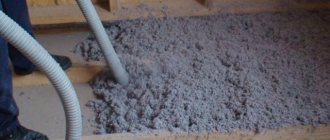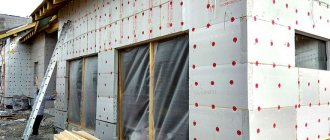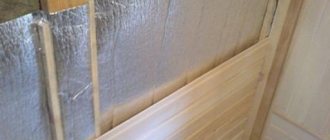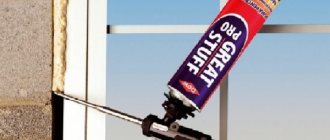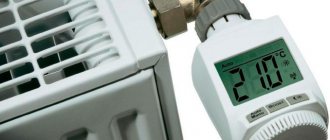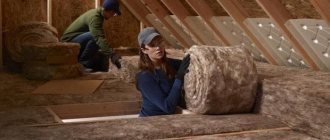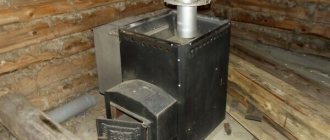Basic rules of insulation: what should you know?
As a result, we will familiarize ourselves with some important rules that everyone should know about.
- The most important rule is that all work should be carried out only after a preliminary calculation of thermal insulation (and based on it). This is explained by the fact that a lot depends on specific factors and characteristics: for example, on the area of the bathhouse, on the number of people for whom it is designed, on the number of rooms and their intended purpose, on the heating system, materials used in construction, etc. .
- The best option is comprehensive insulation, that is, both internal and external. It is better to take care of insulation during the construction of the foundation, walls, and when arranging the roof. Walls, floors, and ceilings are subject to mandatory insulation. For example, the floor in a bathhouse is often a multi-layer structure consisting of solid insulation, a layer of waterproofing, screed and, finally, decorative finishing.
- For walls, a heat insulator, waterproofing and finishing material that partially retains heat are usually used. The ceiling is quite often insulated by arranging a wooden frame, inside of which insulating material is laid.
The best material for insulating a bath
https://www.youtube.com/watch?v=ycr9ySX8epg
The use of foil insulators is not much different from their simpler counterparts. However, there are some nuances that it is advisable to know.
- To enjoy the original Russian entertainment (we are talking about a steam room), you need to finish the bathhouse completely (floor, walls and ceiling). Even the slightest cracks should not be allowed, because such valuable steam will escape through them in a matter of seconds.
- It is best to fasten the insulator using a construction stapler and glue (obligatory heat-resistant). First we coat the strips and fix them on the surface, and then additionally “shoot” them with staples. This technology provides maximum efficiency. The strips are fixed with the aluminum side up. The sheathing is subsequently installed on it.
If you cannot call yourself an experienced craftsman, opt for self-adhesive models. They are a little more expensive than their simple counterparts, but their installation is much easier.
The peculiarities of bath rooms are that you will need to provide not only high temperature inside, but also create the necessary humidity. For this purpose, multilayer structures made of various materials are used.
To determine which foil to use for a bathhouse is better, you need to take into account what material the structure is built from and the conditions of its operation. If the building is made of logs with carefully caulked walls, then it does not require foil insulation.
In the case where the bathhouse is built of natural wood, but is large in area and does not heat up well, experts recommend lining the ceiling and walls from the inside with thin foil, and then covering it with clapboard. You can use a foil sheet for the surface behind the heating unit, as a result of which the steam room will warm up faster.
Despite the fact that a bathhouse made of foam concrete is considered warm, it requires high-quality vapor barrier, so the use of foil will be justified, but it is better to opt for laminated products.
Frame and brick buildings must be insulated. Insulation for a bathhouse with foil based on polystyrene foam and mineral wool is ideal for this (read: “How to insulate a frame bathhouse - nuances from the master”). The type of this material is selected for ceilings taking into account the thickness of the ceiling and the absence/presence of thermal insulation in the attic.
In addition, operating conditions matter. If the bathhouse is used infrequently and the procedures are not carried out for long, there is no need to insulate it with foil. When the steam room is used frequently and is kept in it for a long time, high-quality thermal insulation will save fuel, and the room will quickly warm up and cool down for a long time.
Features of insulation of different types of walls
The choice of insulation directly depends on the material from which the walls in your bath are built. But the insulation work itself and the final “pie”, as a rule, look identical:
- the insulation is attached to a frame made of wooden bars or a metal profile;
- for the steam room, a double layer of insulation is used (to retain heat longer);
- vapor protection and waterproofing are used;
- a counter-lattice is installed (to create a ventilation space), onto which finishing (finishing) materials are stuffed.
Insulation of brick walls
It is recommended to use dowels as fasteners, because... brick, like concrete, is highly durable. You can choose a metal profile as a frame.
ADVICE. Be sure to choose galvanized metal parts to reduce the risk of rust and subsequent deterioration.
For brick baths, a thicker layer of insulation is used, taking into account the region, climate and weather conditions. Minimum thickness – 10 cm.
Insulation of foam concrete walls (or made from other building blocks)
It differs from the insulation of brick walls only in the complexity of installation: walls made of blocks are demanding in terms of load (it should not be excessive) and method of fastening.
We recommend using a U-shaped frame, which must be secured with a pair of self-tapping screws, and using galvanized ties as the remaining connecting elements. So that the frame elements are fastened together and the structure stands on the floor. Thermal insulation layers can be secured using fixing threads (using a nylon cord), the ends of which can be secured using a construction stapler.
Galvanized screed for mounting the insulation frame
Frame and panel walls
Wooden blocks can be used as lathing, the cross-section of which should be equal to the thickness of the insulating layer. It is imperative to make a vapor barrier and waterproofing layer (so that condensation can flow down and not settle on the insulation or wall material). It is necessary to leave a ventilated space between the insulation and the internal walls.
Frame wall pie. Read more about insulating frame walls here.
Insulation of walls in wooden baths
The use of heat-insulating materials in a wooden bath can be limited to only one option: foil. But it also plays the role of a vapor barrier rather than wall insulation. A log bathhouse itself retains heat well and only needs proper insulation of the crowns and high-quality sealing of all cracks.
Product range of possible foil insulating products
Knowing the basic requirements for foil materials, you should consider in detail the types of thermal insulation products. Finishing a bathhouse with foil will take less time if you study all the diversity of the insulation market in advance. Below is a list of the most common ones:
Aluminum foil for the bath. This thermal insulation product is sold in rolls. Rolls in the markets are presented in a wide range. Rolls can be of different widths and lengths. The thickness of the layer can also be different.
Foil in rolls does not have a base. Used for installation on top of an existing mineral insulator. You can use aluminum foil for a bath up to 650 degrees
The owner himself can choose the thickness of the thermal insulation; it is important to remember that the final strength depends on this. The reflectivity of aluminum sheet is usually at least 95%

Installation is carried out with an overlap, with mandatory gluing of the joints with metallized tape. The use of foil for insulation is absolutely safe for human health, since it does not emit toxic substances when heated.
Kraft foil. This thermal insulation material is made on the basis of cellulose; it can also be found in a three-layer design consisting of foil, polyethylene and kraft paper.
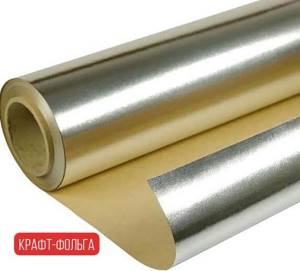
The main properties include high strength, environmental friendliness, and tightness. Kraft foil has a small thickness, which may not exceed 1mm. The surface of the foil has a reflectivity of 95%. Despite the fact that the operating temperature of kraft foil is noticeably lower than that of rolled aluminum sheets, and is only 100 degrees, it is much more convenient to install, since it is less susceptible to mechanical damage and has greater flexibility.
"Folgoizolon". Baths whose walls are lined with this material, if all technology requirements are met, do not require additional insulation measures. In addition to all the main functions, Folgoizolon has soundproofing properties. This product is usually sold in rolls, but you can also find sheet packaging when it is thick. Its base is foamed polyethylene.
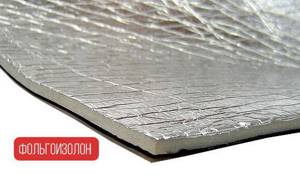
In sheets, "Folgoizolon" has standard dimensions of 600 * 1200 mm with a thickness from 20 to 110 mm. In rolls, the thickness does not exceed 10 mm with a width of 1000 to 1200 mm.
“Folgoizolon” is easy to process during installation, it is not subject to deformation, and can withstand temperatures up to 125 degrees in operation.
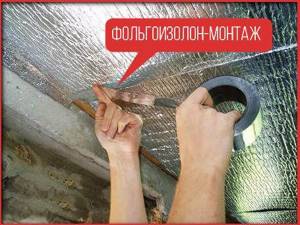
The most popular thermal insulation product on the Russian market is foiled mineral wool. Products based on mineral raw materials have traditionally been used in insulating any premises for many years. In the markets it can be purchased both in rolls and sheets, with a thickness from 30mm to 100mm. The main disadvantage is the presence of an unpleasant installation procedure. Cheap thermal insulation causes irritant reactions in human mucous membranes.
"Penofol". For a bathhouse, this foil thermal insulation can be an excellent product with vapor barrier properties. Being a vapor barrier-based fabric, Penofol not only does not let heat out, but also helps the walls to “breathe.” The reflectivity of the material is about 97%. With such indicators, we can safely say that the thermal insulation of bathhouse walls using Penofol will be better. The thickness of the main heat-insulating layer, as a rule, does not exceed 10 mm. The vapor barrier material can withstand temperatures up to 300 degrees.

Do-it-yourself lining of the steam room with clapboard
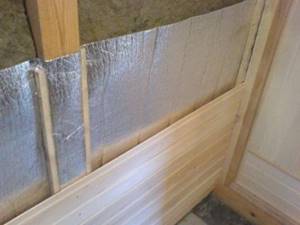
You can finish the inside of the bathhouse with your own hands, following the instructions for installing the casing. This is a step by step process:
- waterproofing is fixed;
- a wooden frame is installed;
- Thermal insulation of walls and ceilings is carried out;
- foil is stretched as a vapor barrier;
- the lining is attached.
Before clapboarding the steam room and other rooms in the bathhouse, the direction of placement of the slats is decided. The decor can be vertical and horizontal. In the first case, the height of the room visually increases, the joints of the boards are hardly noticeable, and it is easier and faster to install the slats. The disadvantage of this method is that it may be difficult to replace the lamellas. In the lower part of the room the humidity is always higher, so the lining can deteriorate. During repairs it will be necessary to saw off the lower part of the lining. Experts recommend the vertical method for the rest room.
When installed horizontally, the products are positioned with the tenon facing upward, which reduces the likelihood of moisture getting inside the finish. This method involves vertical installation of the sheathing, ensuring free air circulation to ventilate the room. If the lower strips are damaged, they can be easily replaced without disturbing the overall design.
Ways to fasten the lining
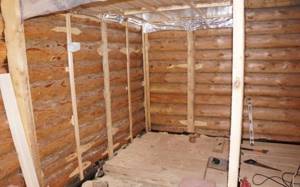
The planks are fixed in two main ways:
- Clamps are a safe fastening option using a special bracket with holes that is placed on a groove. Self-tapping screws are screwed into the bracket; they touch the wood and do not damage its surface. Clamps are made of steel or galvanized iron.
- Nails or self-tapping screws - fastening is carried out using open and hidden methods. The first option is simple to implement, but less aesthetically pleasing, and there is also a risk of getting burned by a heated nail. For hidden installation, the fasteners are driven into the lining tenon. To prevent the board from cracking, a hole is pre-drilled. Self-tapping screws are screwed in using the same pattern. The optimal length of nails is 50-60 mm.
The fastener must be invisible and resistant to moisture. It is recommended to use zinc coated nails and screws. When working with nails, it is better to use an air gun.
Sheathing device
Installing the frame allows you to place the insulation and create a ventilation gap between it and the sheathing, in which air will circulate. The sheathing is made only from wooden beams. The cross-section of lumber depends on the thickness of the thermal insulation, on average it is 20×50 mm. First, a waterproofing sheet is nailed to the walls. Then, starting from the corner, the bars are filled in increments of 50-60 cm. The lumber is pre-treated with a fire retardant and antiseptic.
You can use coniferous timber; the resin it produces will not create any inconvenience. The guides are secured with galvanized nails or self-tapping screws. The lathing is leveled to create an even finishing layer. The timber under the lining is packed perpendicular to the direction of the boards.
Insulation of bath walls and ceilings
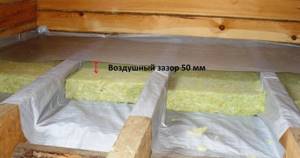
You can start improving the room with insulation. The best option for thermal insulation is basalt wool. Fiber boards do not burn, have a water-repellent impregnation, are easy to lay, and can withstand temperatures up to 1000°C. Manufacturers of mineral wool offer series specially designed for these purposes: warm Knauf bath, Rockwool sauna batts. The slabs are cut with a knife; the recommended width is 2 cm greater than the pitch of the sheathing. In this case, the insulation will fit tightly into the frame. Laying the wool begins from the floor, the layers overlap each other.
Upon completion of installation, the insulation must be covered with a vapor barrier fabric that protects from moisture. Foil works best for this. The material is attached to the sheathing with a stapler, the canvases are laid with an overlap of up to 10 cm, and must be glued with metallized tape.
To insulate rooms, polyurethane foam boards with double-sided foil coating are used. They do not absorb moisture, have a small thickness, and reflect heat. The material is glued to the walls, forming a solid covering, and is additionally fixed with self-tapping screws. The seams are sealed with polyurethane foam. Thermal insulation does not require additional installation of a sheet that prevents getting wet. At the stage of wall insulation, ventilation is installed. You need to cut two holes for it: one under the ceiling, the second 15-20 cm from the floor. An aluminum corrugation with a diameter of 100 mm is suitable for the air duct.
Finishing near the stove in the steam room

The stove serves as a heat source in the steam room; the bulk of the heat occurs in the sections of the wall closest to it. If the lining is placed close to each other, the material may char or catch fire. To prevent problems, the stove is installed at a certain distance:
- metal – 100 cm;
- metal lined with brick – 70 cm;
- brick – 32 cm.
A good choice would be to install a protective screen made of brick or metal, install stainless steel casing, ceramic tiles, or porcelain tiles near the stove.
Wall cladding
Before sheathing the inside of a bathhouse or sauna with clapboards, you need to bring the lumber into the room to adapt to the microclimate. Over the course of a day, the tree acclimatizes to the level of temperature and humidity. The finishing of the steam room starts from the ceiling, then the walls are sheathed. The first board must be mounted at a distance of 20 mm from the wall, this distance is necessary for the free expansion of the wood when heated. The remaining planks are mounted close to each other. To fix the locking connection, the parts are tapped with a mallet with a rubber tip.
First, one end of the lining is nailed, after checking the level, the rest of the part is fastened. Wall and ceiling cladding is performed using the same technology. You need to separate the room from the door. When installed horizontally, the lining is installed from bottom to top, and when installed vertically, from right to left. When fixing the first plank, 20 mm are removed from the floor so that moisture does not rise along the board. The gaps are subsequently closed with decorative elements.
Finishing
In order for the finish to retain its original decorative appearance for a long time, it is necessary to treat it with an antiseptic composition. These can be water-based products, acrylic varnish, wood oil. All preparations have special markings - for baths and saunas. Such compositions protect boards from moisture and rotting, while not releasing toxic substances. All wooden parts are processed, including the frame. Preliminary application of primer allows you to reduce the consumption of varnish and stain.
Performance characteristics by type
Manufacturers offer sauna foil in different designs. This determines their geometric parameters and operational characteristics. We invite you to get acquainted with the main varieties and their features to make it easier to make an informed choice.

Foil comes in different types PHOTO: zharpar.rf
Rolled foil
This material is produced in sheets and rolls. The thickness of the rolled material is 0.007 - 0.2 with a width of 0.01 -1.5 m. For bath insulation, materials with a thickness of 30 - 100 microns are mainly used. Contains about 99.5% aluminum. Depending on the design, the surface of the rolled foil can be:
- smooth, not requiring additional finishing;
- for finishing. After insulation, finishing material is attached to the surface;
- finishing
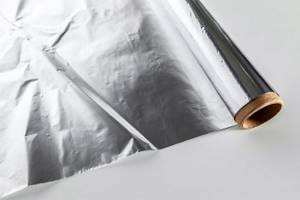
Rolled foil has different thicknesses and widths PHOTO: i0.wp.com
Paper-based foil and foil fabric
Paper-based foil is often called foil or laminated. The material has sufficient elasticity, optimal density and excellent vapor barrier properties. Manufacturers offer two types: based on kraft paper and paper with polyethylene. This insulation:
- able to withstand heat of +130ºС, which is especially important for a bathhouse;
- resists compression load well;
- keeps its shape;
- easy to cut;
- Allows various mounting methods. It is possible to use nails, staples, screws;
- installed inside the bathhouse.

The paper base provides elasticity PHOTO: bannydvor.com
Foil fabric consists of two layers: foil and fabric. It has a thickness of about 0.12 - 3 mm. The sheets in the bathhouse are attached end-to-end. The material can be used to cover walls adjacent to the heating unit. Such material for a bath:
- able to withstand heating up to 500ºС;
- resistant to mold and harmful microorganisms;
- has good moisture resistance.
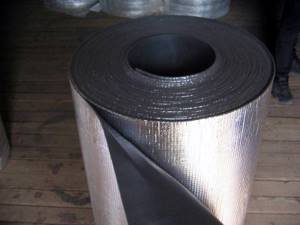
Foil fabric is the best solution for a bath PHOTO: i.sunhome.ru
Foiled polystyrene foam and polyethylene foam
The basis of foiled polystyrene foam is polystyrene foam, onto which a thin layer of aluminum foil is applied during the manufacturing process. Supplied in sheets measuring 1.2 x 0.6 m. It can have a thickness of 2 – 10 cm. The presence of stepped locks helps prevent the appearance of cold bridges. Foiled polystyrene foam is safe for health. Does not absorb moisture. This bath material has:
- reflection of up to 98% of heat;
- good vapor barrier properties;
- chemical resistance;
- long service life.
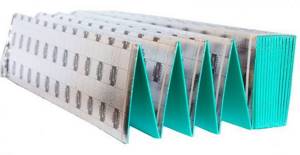
Foligron polystyrene foam is capable of reflecting a large percentage of heat PHOTO: pol-exp.com
Foil polyethylene foam for baths has a thickness of 2–10 cm. The foil can be attached on one or both sides. It is actively used in arranging the interior of a bathhouse. It can heat up to a temperature of no more than 100ºС, which precludes its use for covering the surface adjacent to the furnace.
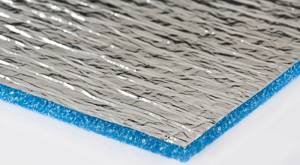
The thickness of foil polystyrene foam is selected individually PHOTO: avatars.mds.yandex.net
Foil mineral wool in rolls and mats
Foil mineral wool is supplied in mats and rolls. May have different thickness. Has good thermal insulation characteristics. Can be used for insulation of frame baths. The convenient release form greatly simplifies installation work.
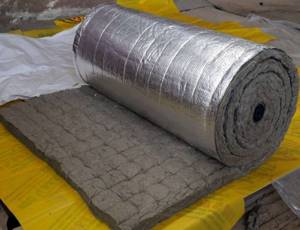
Foil-coated mineral wool is in demand when insulating a bathhouse PHOTO: vosaduly.ru
Insulation materials
Thermal insulation of the steam room is carried out using a variety of materials, ranging from ultra-modern to time-tested. And we will begin our analysis of the characteristics with, perhaps, the most used, but rather outdated material - mineral wool.
Mineral wool
As mentioned above, this material has been known for quite a long time and many experts classify mineral wool as obsolete. Nevertheless, in terms of its thermal insulation characteristics, it is hardly inferior to modern insulation materials. However, this material is quite expensive and is very susceptible to moisture. When wet, mineral wool loses its thermal insulation properties and begins to rot, transferring this process to adjacent wooden structures. In this case, the steam room will have to be insulated anew.
To prevent this from happening, when insulating the steam room from the inside with mineral wool, you should take care of high-quality and reliable hydro- and vapor barrier insulation of all surfaces insulated with mineral wool, that is, walls and ceilings, with foil vapor and water insulators. Vapor barrier of a steam room is very, very important, since with properly performed vapor and waterproofing, mineral wool can last a long time without losing its thermal insulation qualities. It is quite possible to replace mineral wool with stone or glass wool.
Now we will briefly consider one of the most modern thermal insulators for steam rooms - polystyrene foam and how to insulate a steam room in a bathhouse with this material.
Expanded polystyrene
Why will we write briefly about this material? Yes, because it is not entirely suitable for insulating a steam room in a bathhouse. Although its thermal insulation properties are very, very high, it is not afraid of moisture and rodents and mold do not like it, all these advantages disappear when you find out its other side.
Even though polystyrene foam does not burn, it begins to melt at high temperatures. And everything would be fine. But! When melted, this heat insulator releases toxic substances, which can lead to poisoning. And although many still use it, when answering the question of whether it is possible to use polystyrene foam as insulation for a steam room, we strongly advise against doing so.
Let's move on, in fact, to insulating the steam room from the inside, step-by-step instructions for what follows.
Aluminum foil: another scam by manufacturers?
Aluminum foil for bath insulation is a thin (on average 30-300 microns) layer of aluminum, which is used unchanged or in combination with kraft paper, fiberglass, or roll insulation. The main argument of opponents of using foil in a bath is that aluminum has high thermal conductivity.
Based on this, thermal energy can easily pass through the metal layer and end up outside the steam room. In fact, everything is not quite like that. Firstly, high thermal conductivity will “work” against us only in the case of direct contact of the foil with a heated body (for example, with a wooden paneling or blockhouse). Secondly, in addition to thermal conductivity, there are other methods of heat transfer.
What to look for when choosing foil for a bath?
If you intend to purchase suitable foil, you must take into account several factors that affect the durability of the material, the ease of installation and future efficiency. Let's consider the main selection criteria in more detail.
- Foil for a bath with a backing is easier to install on the crate, because the risk of damaging the material in this case will be minimal. In short, we recommend giving preference to this particular material, since it is more practical. The substrate here can be kraft paper, mineral wool or foamed polyethylene. You can also find material with a fiberglass reinforcing layer on the market.
- It is also quite important that the finish’s resistance to high temperatures is at the proper level. This is at least +100 degrees. The insulation must also be resistant to sudden temperature changes, and the foil described in the article (even in the absence of a base) fully meets these requirements.
- Determine the durability of the foil in the bath - find out what the manufacturer himself says about this, it is also advisable to read real customer reviews.
- The reflectivity of high-quality foil insulation should be high - at least 95 percent. This parameter will directly affect the preservation of thermal energy in the bathhouse.
- It is also important that the bath foil is environmentally friendly. When exposed to high temperatures, it should not release any toxic substances.
- If foil is purchased combined with some other insulating material, then be sure to evaluate the thermal resistance of the latter.
- The strength characteristics of the selected material are also very important (especially in terms of ease of installation).
- Finally, the vapor permeability of foil should be no more than 0.01 grams per square meter per day.


Rolled aluminum foil
Foil is produced in both rolls and sheets. Roll material can have a thickness from 0.007 to 0.2 millimeters, a width of 10–1500 millimeters. The percentage of aluminum content in it is up to 99.5%.
Depending on the type of surface, foil is:
- smooth, without additional finishing;
- for finishing;
- finishing
Depending on the manufacturing method, foil is distinguished:
- soft (annealed), marked “M”;
- solid (unannealed) – it is assigned the letter “T”.
Thin fabric is wound on bushings having different diameters. Thick foil is produced in sheets.
Before starting insulation work, developers are interested in how much foil for a bathhouse costs. Domestic roll products will cost less than imported material. With a roll length of 25-30 meters, the price will be approximately 20-30 dollars.
Photo of a roll of foil
For high-quality thermal insulation of the steam room, the insulation material must have increased water resistance and fire resistance.
Foil for baths and saunas is ideal for these parameters.
Characteristics
- There is no effect of deformation at high temperatures.
- Aluminum does not emit fumes harmful to humans.
- High level of vapor barrier. Thanks to this, hot steam does not escape from the room, but fulfills its purpose.
The steam must remain inside to achieve the correct effect
No steam accumulation in the material itself. This significantly increases the service life. Acceptable price. No condensation on the walls
This is especially important in the case of wooden walls. Since the presence of condensation can lead to the appearance of mold and rotting processes. Insulating the material from the harmful effects of excessive humidity and other possible effects
This extends the life of the building itself. Heat reflection effect. The aluminum surface reflects thermal radiation, which significantly speeds up the heating of the steam room, which allows you to save on heating costs. Easy to install. Affordable DIY implementation. Durability. Does not rust, does not rot, and is not attacked by pests.
Which foil is best for a bath?
Let's look at its most prominent representatives:
Folgoizolon for baths is polyethylene coated with aluminum foil. To all of the above qualities, a high level of noise insulation is added and increases strength. And heat conservation is carried out not only due to reflective properties, but also by reducing thermal conductivity.
Folgoizolon sheet
Paper-based foil for baths significantly increases the strength and reliability of the product and is an environmentally friendly material.
Extra layer of paper for added durability
Foil insulation for a bathhouse is any classic insulation material, such as isolon or even mineral wool, in which one of the sides is covered with a layer of foil to increase waterproofing, fire safety and protection from the aggressive environment of the steam room. The cost increases accordingly depending on the combined insulation.
Roll of foiled mineral wool
Thus, all varieties simply involve adding an additional layer, which adds some quality, but also increases the cost. In order to save money, regular bath foil is suitable, as it already has a sufficient number of necessary qualities.
Installation
The following instructions will help you install the foil:
- We buy a sufficient amount of foil with a thickness of 100 microns.
- We fix the foil to the boards using a stapler, furniture nails or tacks. At the same time, we make overlaps of several centimeters.
- We fasten the aluminum strips together with mounting tape.
Connect with construction tape
The process of strengthening the sheathing strips
We install the inner finishing layer.
It should be noted that when using an additional insulating layer, it is installed in front of the foil.
For example, if it is mineral wool, then we do the following:
- We nail wooden blocks with a cross section of 5 cm by 5 cm onto the walls and ceiling of the steam room. In this case, we keep the distance between them equal to the width of the insulation boards.
- We put insulating material between them.
- The above installation steps follow with one clarification: the foil is fixed to the intermediate strips.
Foil over mineral wool
If you use bath insulation with foil, the covering process is even simplified and becomes more cost-effective than purchasing and installing them separately.
Methods for attaching panels to walls
Using nails or self-tapping screws is the traditional option for attaching panels to walls. A more modern method is the use of clamps. It does not damage the panels, but requires additional costs of both time and money when installing the lining.
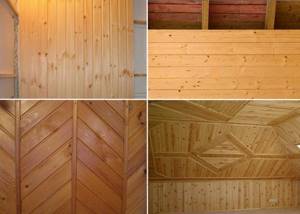
Using nails or screws
This method will require a screwdriver or hammer, as well as special nails or self-tapping screws - galvanized or made of copper alloy. Such fittings are more expensive, but if you save on them and buy ordinary nails, they will begin to rust over time. This will lead to the appearance of red streaks on the lining, which will spoil the appearance of the finish and stain the skin and things when touched. The fasteners are driven or screwed into the lining tenon at an angle of 45 degrees. The fastening points will have to be sanded so that there are no burrs or other defects left. The disadvantage of this method is that holes will have to be created on the planks when fastening them with nails. And when you try to remove the lining, the fastening points will be further damaged, which precludes the reuse of the panels if necessary.
Fastening with clamps
Do-it-yourself installation using clamps is safe for lining strips because it does not damage them. A clamp is a special bracket that is attached to the lower half of the lining groove - a recess into which the tenon of the next plank is inserted. The fastenings of the bracket are covered with the next strip in the row. Fixing the staples to the sheathing beams is carried out with nails or self-tapping screws.
With this installation method, the lining is not damaged, and there are no nail heads or screws left on the outer surface of the cladding, which eliminates the risk of getting burned or getting a rusty drip on your clothes after visiting such a bathhouse.
It is also easier to partially replace the lining mounted in this way - just pull the boards out of the grooves and pull out the fasteners. If you do not work carefully, it will be the staples that are damaged, not the boards.
We recommend reading:
Ventilation in the bath: purpose and installation
Application of foil vapor barrier
Izolon
If you decide to use such material when building a bathhouse on your summer cottage, this does not mean at all that you need to incur significant expenses. You don't need to invest a lot of money to insulate the entire building. The optimal solution is installation exclusively in the steam room and shower room. The foil layer effectively accumulates heat, and the polymer inside reliably protects the structure from moisture and steam. For other rooms, you can simply purchase simpler and cheaper material.
In addition to insulating the walls, foil material must also be installed on the ceiling, under which hot air and steam collect in the steam room. It is advisable not to forget to use it on doors. But it’s not worth laying any foil insulation on the floor, since its construction here usually consists of a concrete screed with a wooden deck on top. The exception here is warm water floors.
Types of suitable insulation materials
In our opinion, it makes sense to divide the types of thermal insulation materials for baths into sheet, roll and backfill. In addition, there are insulation materials that are applied to the walls in the form of foam or a moistened mass - these are polyurethane foam and ecowool, which are sprayed using special equipment.
Mineral wool can be purchased in rolls or sheets. It all depends on its density and the binders used.
BY THE WAY! We rarely name specific brands, but do you understand that the names Rockwool or Isover hide the same mineral wool produced by different companies?
Basalt wool is a type of mineral wool, a literal reference to the similar mineral used. There is practically no difference.
Basalt wool for baths
But you shouldn’t confuse mineral wool and glass wool - these are different insulation materials, made from different materials and with different properties.
Glass wool should no longer be used anywhere, because it is extremely unpleasant for humans - if it gets on the skin, it causes itching, and it is hazardous to health if it gets into the eyes or respiratory organs. Yes, and fiberglass crumbles during operation, turns into dust, and it penetrates through the cracks, and you breathe it.
Does not like fiberglass insulation and elevated temperatures typical of a bathhouse.
Polystyrene foam and extruded polystyrene foam are good insulation materials, especially the latter, but using them in a bathhouse is dangerous. They are absolutely not suitable for a steam room, but could (theoretically) be used in other rooms, but we will not recommend them, since they are a fire hazard.
ADVICE! In the bathhouse, polystyrene foam and penoplex can be used in floors under concrete screed - there they do not pose any danger.
So, sheet insulation is mineral wool, foam glass (excellent, but expensive insulation), calcium silicate and magnesium silicate sheets, non-recommended polystyrene foam and extruded polystyrene.
Foam glass
Roll insulation is again mineral wool (lower density), glass wool. foamed polyethylene, with or without foil (penofol, isolon, etc.).
We have already spoken about fiberglass, now about foamed polyethylene. It is often used as additional insulation in residential buildings, but polyethylene does not tolerate high temperatures, so it should not be used instead of foil to insulate a steam room.
Foil insulation Penofol
IMPORTANT! Polyethylene already melts at a temperature of one hundred degrees. By the way, it supports combustion.. In general, it is quite possible to insulate other rooms of the bathhouse with it (as a second layer)
In general, it is quite possible to insulate other rooms of the bathhouse with it (as a second layer).
We will divide bulk insulation for baths into those that can be moistened and “glued” to the wall, and those that cannot. Expanded clay and vermiculite belong to the second category, ecowool - to the first.
Expanded clay and vermiculite can be used to insulate floors and ceilings, where they adhere perfectly and retain heat indoors. In order to insulate the walls of a bathhouse with them, it is necessary that between the two layers of the main wall material there is a gap, a cavity that can be filled with insulation.
Expanded clay
Ecowool is waste paper (cellulose) crushed into dust, impregnated with fire retardants so that it does not support combustion. And it really doesn’t support it - this is a good material for insulating baths where it is on sale. Ecowool is used in dry and wet form. In dry conditions - for insulating floors and ceilings, as well as for filling cavities. When wet - for application to walls.
Insulating the roof with ecowool using the wet method. Cromwell Photos
Also on our website you can read two articles that provide a more complete overview of insulation materials that can be used in a bathhouse:
- review of bath insulation;
- choosing the best of natural and artificial insulation for a bath.
Floor insulation
Heat leaves the bathhouse not only through the walls, but also through the floor. Expanded clay is used for thermal insulation of floors. This is an inexpensive, effective and reliable material. Although you can use slag for work, expanded clay provides a better degree of environmental safety and has less weight.
If the floor in the bathhouse is concrete, then when installing it, each layer is laid with expanded clay. Here's how to insulate the floor in a bathhouse with your own hands:
- When pouring concrete, you need to wait until it is completely dry.
- A plastic film is placed on the concrete.
- Then you need to pour expanded clay. It is believed that the thickness of the layer should be twice that of the walls. If the room allows, it is advisable to increase it even more.
- Subsequently, they are laid out on a reinforced lattice.
- At the end of laying the floor, a concrete-sand screed is made.
Insulation of the floor in the bathhouse is carried out, if it is wooden, by pouring this material between the joists.

Before laying expanded clay, you need to lay a layer of roofing felt or vapor barrier film. When thinking about how to properly insulate a bathhouse, we must not forget about the reflective and vapor barrier layers.
When using expanded clay for thermal insulation, you need to take into account that its layer must have a flat surface. In order to ensure this, guides are used: a profile is attached horizontally to the floor, with the help of which it will be possible to control the uniformity of the pouring of the material.
Sometimes the bathhouse has an earthen floor. Here are step-by-step instructions on how to make it insulated:
1. It is necessary to trample the surface, making the earth denser. 2. It is recommended to impregnate the walls with a waterproofing compound. 3. Add a ten-centimeter layer of sand to the soil, pour water over it and compact it. 4. Lay the sand with roofing felt
It is important to ensure a 15 cm overlap on the walls. You can fasten the sheets using tape
For concrete floor
When thinking about how to insulate a bathhouse from the inside, you can use another method for high-quality thermal insulation of the floor.
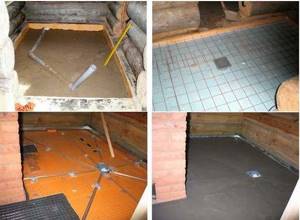
Here's how to insulate a bathhouse from below:
- In place of the floor, a pit 50 centimeters deep is dug.
- Lay out a 5 cm layer of sand.
- Next you need to put 20 centimeters of polystyrene foam. Now you need to prepare a mixture of concrete with foam chips (1:1). And put a five-centimeter layer.
- Waterproofing is laid on top. This can be a layer of roofing material or a special vapor barrier film.
- Place a mixture of vermiculite and concrete. It is prepared in a one to one ratio. The thickness should be 5 centimeters.
- The top layer is a reinforced concrete screed.
Related Posts
- Arrangement of the bathhouse inside
- Foil insulation: types, properties and possibilities of use
- Which side of the foil should you place food for baking on?
- Bathhouse made of foam blocks
- Construction of a frame bath with your own hands
- Do-it-yourself insulation of walls with polystyrene foam - detailed instructions
- How to insulate the ceiling in a bathhouse with your own hands
- What and how to build a simple bathhouse in the country?
- How to cover the inside of a bathhouse with clapboard with your own hands
- We insulate the wall of the apartment from the inside with our own hands
- Properties and types of dowel mushrooms for fastening insulation
- Isover thermal insulation overview
- Choosing non-flammable insulation for walls and ceilings: tips and tricks
- When health is in your hands: a bathhouse that will be the envy of your neighbors
- Choosing insulation for a bath: features of organic and inorganic types
- Mineral wool, its characteristics and insulation composition
- Is it worth replacing wallpaper with paint in an apartment: what to paint with, is it possible to do the work yourself, and what paint to choose for the wall
- Insulating the attic with foam plastic
- How to glue fiberglass correctly?
- Insulation of a concrete floor in an apartment
- Insulation of a veranda in a wooden house
- Subtleties of attic floor insulation
- How not to spoil the efficiency of a heating battery with a decorative screen
- Secrets of stove makers: brick stove for a bath
- Insulation of facades. insulation for exterior walls of a house
Read with this
- Arrangement of the bathhouse inside
- Foil insulation: types, properties and possibilities of use
- Which side of the foil should you place food for baking on?
- Bathhouse made of foam blocks
- Construction of a frame bath with your own hands
- Do-it-yourself insulation of walls with polystyrene foam - detailed instructions
- How to insulate the ceiling in a bathhouse with your own hands
- What and how to build a simple bathhouse in the country?
- How to cover the inside of a bathhouse with clapboard with your own hands
- We insulate the wall of the apartment from the inside with our own hands
The main advantages of the material
The high popularity of foil insulation for baths is due to an impressive list of its advantages:
The so-called “thermos effect” is created, that is, when heat does not escape from the room at all. This type of insulation is simply ideal for baths and saunas, as it allows you to preserve precious steam as reliably as possible.
Tip: Effective thermal insulation will significantly reduce energy costs. As a result, the bath will warm up much faster.
This insulation provides excellent protection against moisture and vapors. Therefore, there is no need to create a water-repellent layer
This is extremely important for wooden buildings. One of the main features is absolute resistance to temperature changes. They are achieved thanks to the presence of a heat-repellent layer
Simple roll insulation materials will only last a few years when used in such conditions. Reducing the thickness of the required insulation layer. This property is achieved through the use of special foil, which increases the efficiency of thermal insulation. Increasing the noise insulation properties of the room. Absolute environmental cleanliness. High hygiene is an important factor for premises of this kind. Very light weight (except for mineral wool). This makes installation and transportation easier. In addition, there is no need to build a frame (in most cases this is the most labor-intensive procedure).
Please note that a similar group of materials is used in many other areas (from apartment buildings to car showrooms). It is perfect for use in conditions of high humidity and sudden temperature fluctuations.
When arranging a steam room, you should be especially careful when deciding which foil is best for a bath, since the material must be environmentally friendly and reflect heat well. All these requirements are met by insulation materials with aluminum foil coating.
Advantages of foil insulation:
- The material is universal because it is used for walls, ceilings and bath floors.
- Insulation with foil coating has good light reflection.
- Products are produced in a wide range.
- They are used in damp areas and do not require treatment with fungicidal compounds.
- They have high hygienic indicators. The properties inherent in aluminum do not create a breeding ground for the growth of fungus and mold.
- They do not deform and do not melt in the steam room at elevated temperatures.
- The material is convenient to work with. It is easy to mount and fix on different planes: vertical, horizontal and inclined.
Tips for insulating baths:
- If the bathhouse building does not have a commercial purpose, finishing the walls with 3 mm foil in rolls will be sufficient.
- For commercial enterprises, the solution to the problem of which foil to choose for a bath is the use of laminated products on a basalt mineral base.
When insulating a bathhouse located inside a permanent building, you need to take into account the functioning of central heating, since it additionally heats the air.
The main advantages of bath foil
Due to the operational and climatic characteristics of the bath room, a number of requirements can be identified that the aluminum foil used must necessarily meet:
- high moisture and steam resistance;
- appropriate thermal conductivity;
- fire resistance;
- high reflectivity (from 95 to 98 percent), which is obtained thanks to special polishing of the outer layer;
- excellent anti-corrosion properties.
As we have already found out, high vapor barrier characteristics prevent the leakage of heated steam from the room, and it will not accumulate in the coating.

In addition, aluminum foil for a bath has other advantages:
- it does not deform and does not lose its original properties;
- it protects neighboring premises, if any;
- the material is plastic, even if exposed to high temperatures for a long time;
- is characterized by increased resistance to chemicals;
- does not emit harmful gases and compounds;
- hygienic, durable;
- UV resistant;
- extremely easy to install.
Note! If you handle the foil carefully, even the thinnest sheets will not tear or deform. But in any case, it is necessary to purchase the material with a small margin (at least 5 percent).
The maximum temperature that the foil can withstand can reach 145 degrees. Thanks to the creation of the so-called thermos effect, the heat inside is retained for about 2.5 hours longer. We also note that the material can be used both for walls and for floors and ceilings (that is, it is universal), and does not require any special treatment with fungicides at all.

Classification of foil: types and properties
To select the optimal model, it is necessary to determine the functional purpose of the foil layer. In a steam room, it can serve as a reflection of thermal energy. But for this, the material should not be closed, otherwise the meaning of its use is lost. Also, a layer of foil can be installed in the area of the heater to maximize the concentration of thermal radiation into the room.
When arranging a bathhouse yourself, it is recommended to use aluminum foil with a backing. This will reduce installation time and labor intensity. This approach is due to the relative fragility of foil materials - even a slight excess of mechanical stress can cause the layer to rupture.
Roll without base
The best option for improving the thermal insulation qualities of the steam room. The material is a roll of aluminum foil, up to 250 microns thick. Length varies from 5 to 20 meters, width – up to 1500 mm. The maximum temperature limit for this material is +650°C.
Features of installation and operation:
- rolls are mounted overlapping;
- special foil tape is used for fixation;
- the material must fit tightly to the insulation;
- installing two or more layers does not make sense, since it will not affect the increase in heat-reflecting properties.
The average cost of 1 m² is 48 rubles.
Reinforced foil
It is necessary for arranging walls, ceilings and floors with a complex configuration with many indirect elements and angles. Unlike conventional rolled material, reinforced foil has an additional layer of fiberglass mesh. It increases the mechanical strength of the reflective surface.
- some models have an adhesive backing to simplify installation;
- joining several sheets is also done using tape;
- You can purchase rolls with one-sided or double-sided foil coating;
- Roll length up to 50 m, width 100 cm.
Despite all the advantages of the reinforced model, it is rarely used for arranging a bathhouse. This is due to the high cost - from 150 rubles per 1 m².
Kraft foil
To improve mechanical strength and durability, a new type of heat-reflective material was developed that combines a base of impregnated paper and aluminum foil. In fact, it is an insulation material that combines the properties of cellulose to retain heat and reflect IR radiation.
To increase safety, the paper is impregnated with fire retardants. In addition, the material has the following properties:
- Possibility of installation directly on the inside of a wooden wall;
- the small thickness will not affect the reduction in the useful volume of the steam room;
- increasing tensile strength.
The average cost of kraft foil is 110 rubles per 1 m².
With thermal insulation materials
To fully insulate a bathhouse, it is recommended to use heat insulators, one of the sides of which is foil-coated. The reflective layer is applied to the adhesive base, this increases the strength characteristics of the foil and allows you to create reliable thermal insulation.
The following are used as insulation:
- Basalt (stone) wool. The best option for a bath or sauna. It is heat-resistant, its structure allows moisture to pass through, which is a prerequisite for a steam room.
- Foamed polyethylene. It has increased flexibility and is waterproof.
- Extruded polystyrene foam or polystyrene foam. Budget options for insulating a bath.
The presence of a layer of foil does not greatly affect the cost of these heat insulators.
For a bathhouse, it is better to choose insulation with a foil side. This will reduce labor costs and allow you to maintain the required microclimate characteristics in the room.
When building a bathhouse, the main task is to create a structure that will quickly warm up and retain heat for as long as possible. For this purpose, the walls and ceiling are insulated. Aluminum foil for baths is most often used as insulation. There are several types of this material, differing in strength, ease of installation, durability and service life. When choosing a specific type of foil insulation, you need to focus on the characteristics of the building.
Purpose of the foil layer for a bath
When insulating a bath, foil can perform various functions. It is used as an independent reflective heat insulator or as one of the layers of a heat-insulating cake. By placing foil between the lining and a layer of thermal insulation, it is possible to create the effect of a thermos. This is the best option for a brick, concrete or frame structure.
If the foil is used alone, it acts solely as a reflector or vapor barrier, protecting vulnerable materials from moisture. With its help, it is possible to increase the air temperature in a small steam room and protect the walls of the bathhouse adjacent to the stove from possible fire.

Date: September 25, 2021
